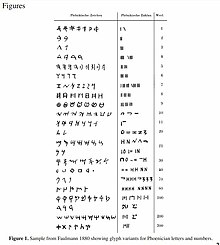
Back علم الأعداد اليهودي Arabic Gematriya Azerbaijani Guematria Catalan Gematrie German Γεματρία Greek Gematría Spanish جماتریا Persian Gematria Finnish Gematria French גימטריה HE
This article has multiple issues. Please help improve it or discuss these issues on the talk page. (Learn how and when to remove these messages)
|
In numerology, gematria (/ɡəˈmeɪtriə/; Hebrew: גמטריא or גימטריה, gimatria, plural גמטראות or גימטריות, gimatriot)[1] is the practice of assigning a numerical value to a name, word or phrase by reading it as a number, or sometimes by using an alphanumerical cipher. The letters of the alphabets involved have standard numerical values, but a word can yield several values if a cipher is used.

According to Aristotle (384–322 BCE), isopsephy, based on the Milesian numbering of the Greek alphabet developed in the Greek city of Miletus, was part of the Pythagorean tradition, which originated in the 6th century BCE.[citation needed] The first evidence of use of Hebrew letters as numbers dates to 78 BCE; gematria is still used in Jewish culture. Similar systems have been used in other languages and cultures, derived from or inspired by either Greek isopsephy or Hebrew gematria, and include Arabic abjad numerals and English gematria.
The most common form of Hebrew gematria is used in the Talmud and Midrash,[2][3] and elaborately by many post-Talmudic commentators. It involves reading words and sentences as numbers and assigning numerical instead of phonetic values to each letter of the Hebrew alphabet. When read as numbers, they can be compared and contrasted with other words or phrases – cf. the Hebrew proverb נכנס יין יצא סוד (nichnas yayin yatza sod, lit. 'wine entered, secret went out', i.e. "in vino veritas"). The gematric value of יין ('wine') is 70 (י=10; י=10; ן=50) and this is also the gematric value of סוד ('secret', ס=60; ו=6; ד=4).[4]
Although a type of gematria system ('Aru') was employed by the ancient Babylonian culture, their writing script was logographic, and the numerical assignments they made were to whole words. Aru was very different from the Milesian systems used by Greek and Hebrew cultures, which used alphabetic writing scripts. The value of words with Aru were assigned in an entirely arbitrary manner and correspondences were made through tables,[5] and so cannot be considered a true form of gematria.
Gematria sums can involve single words, or a string of lengthy calculations. A short example of Hebrew numerology that uses gematria is the word חי, chai, 'alive', which is composed of two letters that (using the assignments in the mispar gadol table shown below) add up to 18. This has made 18 a "lucky number" among Jews.
In early Jewish sources, the term can also refer to other forms of calculation or letter manipulation, for example atbash.[6]
- ^ Cite error: The named reference
JEwas invoked but never defined (see the help page). - ^ Genesis Rabbah 95:3. Land of Israel, 5th Century. Reprinted in, e.g., Midrash Rabbah: Genesis. Translated by H. Freedman and Maurice Simon. Volume II, London: The Soncino Press, 1983. ISBN 0-900689-38-2.
- ^ Deuteronomy Rabbah 1:25. Land of Israel, 5th Century. Reprinted in, e.g., Midrash Rabbah: Leviticus. Translated by H. Freedman and Maurice Simon. Volume VII, London: The Soncino Press, 1983. ISBN 0-900689-38-2.
- ^ Babylonian Talmud, tractate Sanhedrin 38a, see of Zuckermann, Ghil'ad (2006), "'Etymythological Othering' and the Power of 'Lexical Engineering' in Judaism, Islam and Christianity. A Socio-Philo(sopho)logical Perspective", Explorations in the Sociology of Language and Religion, edited by Tope Omoniyi and Joshua A. Fishman, Amsterdam: John Benjamins, pp. 237–258.
- ^ LIEBERMAN, Stephen (1987). "A Mesopotamian Background for the So-Called Aggadic 'Measures' of Biblical Hermeneutics?". Hebrew Union College Annual. 58: 157–225. JSTOR 23508256.
- ^ "Sanhedrin 22a". Archived from the original on 2022-10-31. Retrieved 2019-05-09.